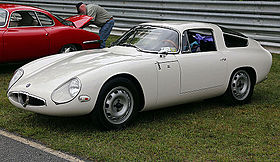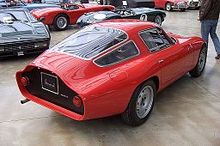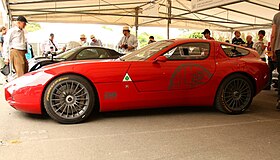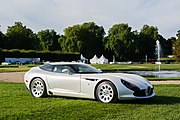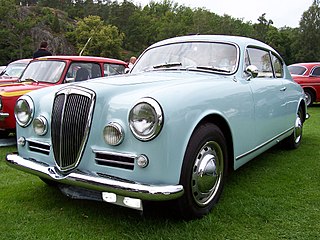
A grand tourer (GT) is a type of car that is designed for high speed and long-distance driving due to a combination of performance and luxury attributes. The most common format is a front-engine, rear-wheel-drive two-door coupé with either a two-seat or a 2+2 arrangement. Grand tourers are most often the coupé derivative of luxury saloons or sedans. Many iconic car models, such as the Ferrari 250 GT, Jaguar E-Type, and Aston Martin DB5, are considered classic examples of gran turismo cars.

Zagato is a coachbuilding company. The design center of the company is located in Terrazzano, a village near Rho, Lombardy, Italy.

Asardo is a brand of sports car built in the United States. The first car was built in 1959 and subsequently modified by the designer in 1961. Only one was ever built.

Alfa Romeo Giulia is the name of three not directly related models by the Italian car manufacturer Alfa Romeo. The first is a line of sporty four-door compact executive cars produced from 1962 to 1978, the second is an updated, mainly up-engined Spider, Sprint and Sprint Speciale Giuliettas, and the third Giulia is a compact executive car unveiled in 2015.

The Alfa Romeo Montreal is a 2+2 coupé sports car produced by the Italian manufacturer Alfa Romeo from 1970 to 1977.

The Alfa Romeo GTA is a coupé automobile manufactured by the Italian manufacturer Alfa Romeo from 1965 to 1971. It was made for racing (Corsa) and road use (Stradale).
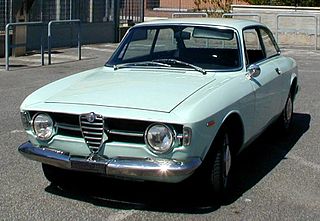
The Alfa Romeo 105 and 115 series coupés are a range of cars made by the Italian manufacturer Alfa Romeo from 1963 until 1977, based on a shortened floorpan from the Giulia saloon. They were the successors to the Giulietta Sprint coupé.
The Alfa Romeo Tipo 33 was a sports racing prototype raced by the Alfa Romeo factory-backed team between 1967 and 1977. These cars took part for Sport Cars World Championship, Nordic Challenge Cup, Interserie and CanAm series. A small number of road going cars were derived from it in 1967, called Alfa Romeo 33 Stradale.

The Alfa Romeo 33 Stradale is a mid-engine sports car built by Italian automobile manufacturer Alfa Romeo. It was the fastest commercially available car for the standing kilometer upon its introduction. 18 examples were produced between 1967 and 1969. "Stradale" is a term often used by Italian car manufacturers to indicate a street-legal version of a racing car; indeed the 33 Stradale was derived from the Tipo 33 sports prototype. Built in an attempt by Alfa Romeo to make some of its racing technology available to the public, it was also the most expensive automobile for sale to the public in 1968 at US$17,000.
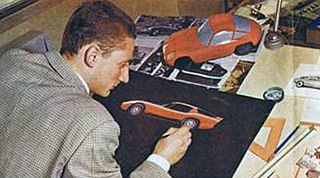
Ercole Spada is an Italian automobile designer. His most notable designs were produced in the 1960s, for the Zagato design studio house, where Spada was chief stylist. During this period some of the most notable sports cars by Aston Martin, Ferrari, Maserati, as well as Alfa Romeo, Abarth, Fiat and Lancia were clothed by Spada's designs.

The Alfa Romeo Giulietta is a family of automobiles made by Italian car manufacturer Alfa Romeo from 1954 until 1965 which included a 2+2 coupé, four-door saloon, estate, spider, Sprint, and Sprint Speciale. The 2+2 was Alfa Romeo's first successful foray into the 1.3-litre class. From 1954 to 1965 a total of 177,690 Giuliettas were made, the great majority in saloon (Berlina), Sprint coupé, or Spider body styles, but also as Sprint Speciale and Sprint Zagato coupés, and the rare Promiscua estate.

The Alfa Romeo 8C Competizione is a sports car produced by Italian marque Alfa Romeo between 2007 and 2010. It was first presented as a concept car at the 2003 Frankfurt Motor Show. The name refers to the eight-cylinder engine (8C) and Alfa Romeo's racing pedigree. The company received over 1,400 orders for the 8C after the official announcement that the car would enter production. However, only 500 customers ended up with the 8C Competizione and another 329 with the 8C Spider, bringing the production total to 829 cars.
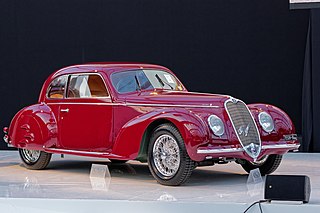
The Alfa Romeo 6C name was used on road, race, and sports cars produced between 1927 and 1954 by Alfa Romeo; the "6C" name refers to the six cylinders of the car's straight-six engine. Bodies for these cars were made by coachbuilders such as James Young, Zagato, Touring Superleggera, Castagna, and Pinin Farina. Beginning in 1933 there was also a 6C version with an Alfa factory body, built in Portello. In the early 1920s Vittorio Jano received a commission to create a lightweight, high performance vehicle to replace the Giuseppe Merosi designed RL and RM models. The car was introduced in April 1925 at the Salone dell' Automobile di Milano as the 6C 1500. It was based on Alfa's P2 Grand Prix car, using a single overhead cam 1,487 cc in-line six-cylinder engine, producing 44 horsepower. In 1928 the 1500 Sport was presented, which was the first Alfa Romeo road car with double overhead camshafts.

The ALFA 24 HP is a 4.1-litre four-cylinder passenger car, the first model produced by Italian car manufacturer ALFA, which in 1919 would become Alfa Romeo. It was introduced in 1910, the year ALFA was founded, and produced until 1914 in ALFA's Portello factory near Milan. The model's name comes from its tax horsepower rating, then frequently used as vehicle designation.

The Alfa Romeo Gran Sport Quattroruote is a two-seater roadster made between 1965 and 1967 by Italian car manufacturer Alfa Romeo and the coachbuilder Zagato. The car wears retro bodywork by Zagato, replicating the Alfa Romeo 6C 1750 Gran Sport Spider Zagato of the early 1930s, over then-modern Alfa Romeo Giulia mechanicals. Just 92 were made.

The Dodge Viper is a sports car that was manufactured by Dodge, a division of American car manufacturer FCA US LLC from 1992 until 2017, having taken a brief hiatus in 2007, and from 2010 to 2012. Production of the two-seat sports car began at New Mack Assembly Plant in 1991 and moved to Conner Avenue Assembly Plant in October 1995.
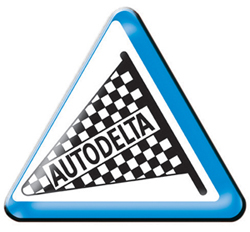
Autodelta SpA was the name of Alfa Romeo's competition department. Established in 1961 as Auto-Delta by Carlo Chiti and Lodovico Chizzola, former Alfa Romeo and Ferrari engineers, the company was officially made a department of Alfa Romeo on March 5, 1963 by the then president of Alfa Romeo Giuseppe Luraghi. Originally based in Feletto Umberto, Udine, the team subsequently moved closer to Alfa Romeo's facilities in Settimo Milanese in 1964, officially becoming Autodelta SpA. The move enabled Autodelta to use the Balocco test track for new racing cars and prototypes.

The Fiat-Abarth 750 is a compact sporting series of automobiles manufactured by the Italian manufacturing firm Abarth & C. of Turin, Italy in the 1950s and 1960s. The cars used the floorpan and often the bodywork of the Fiat 600 but were fitted with Abarth's modified engines. Abarth also offered a number of bodyworks by other designers for the 750 and its derivatives, most famously Zagato but also Allemano and others.
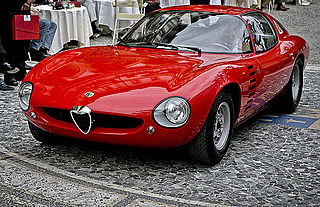
The Alfa Romeo Canguro is a concept car designed by Giorgetto Giugiaro at Bertone. The car is based on the chassis of an Alfa Romeo TZ and was shown at the 1964 Paris Motor Show. The body is made of fiberglass rather than aluminium and it features one of the first glued in windscreens in a car. The name "Canguro" means Kangaroo in Italian.

The Viper engine is a high-performance naturally-aspirated pushrod 2 valves-per-cylinder 90° V10 engine designed by Chrysler but with aluminum block castings designed by Lamborghini for use in the Dodge Viper. Despite its large displacement, it is based on the Chrysler LA V8.
